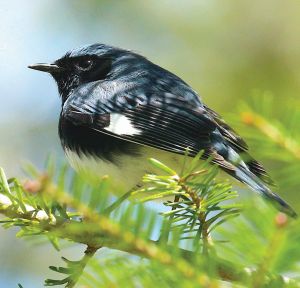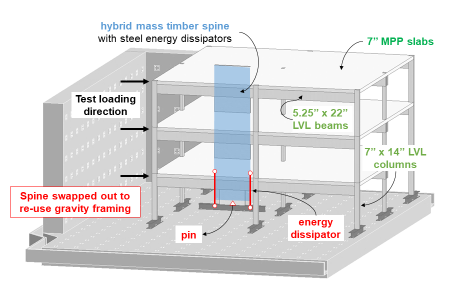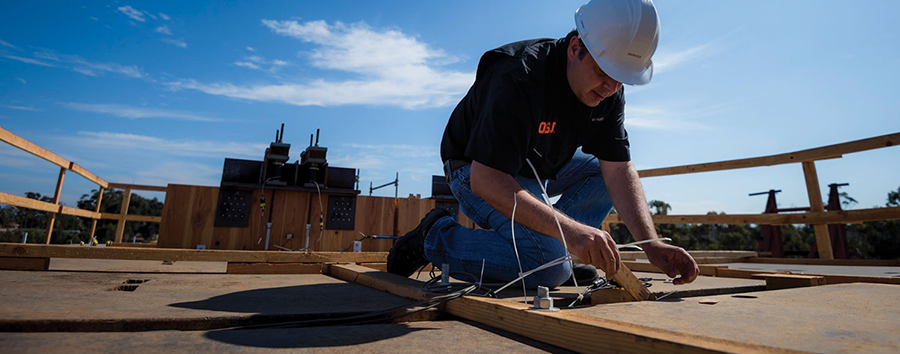
Forest birds with short, round wings more sensitive to habitat fragmentation
Tropical forest birds tend to have wings that are short and round relative to their body length and shape. Professor Matt Betts, the Ruth H. Spaniol chair of renewable resources, and Christopher Wolf, a postdoctoral scholar, found these birds are more sensitive to habitat fragmentation than species common in temperate forests. This study, published in “Nature Ecology and Evolution,” provides solid evidence for the idea that forest birds in the lower latitudes struggle to relocate when their habitat breaks up because they weren’t required to evolve in ways that promote movement to new areas. Birds from temperate forests, like jays, robins and migrant warblers tend to be better movers as they have long, narrow wings that are better suited to long-distance flight.
Bees flock to clearcut areas but decline as forest canopy regrows
Doctoral Student Rachel Zitomer and Associate Professor of Wildlife Ecology Jim Rivers studied 60 intensively managed Douglas-fir (Pseudotsuga menziesii) stands of multiple ages, including within the OSU Research Forests. They found that bee abundance and species richness declined rapidly with stand
age, decreasing by 61% and 48%, respectively, for every five years since timber harvest. This research is one of the first attempts to study how native bee communities change over time in the Oregon Coast Range. Management activities that keep the forest canopy open for a longer period during the initial stage of stand regeneration may enhance bee diversity in landscapes dominated by intensively managed conifer forests.
Temperature, more than drought, caused heat dome tree damage.
In June 2021, the Pacific Northwest had multiple days of record setting, triple-digit temperatures resulting in widespread tree scorch. A team led by Professor Christopher Still attributes the damage more to the temperature than to drought conditions, citing evidence that leaf discoloration and damage are consistent with direct exposure to solar radiation in combination with extreme air temperatures. A previous article had concluded that the trees’ problems were the result of drought and a failure in the trees’ hydraulic system. The coastal Douglas-fir and western hemlock plantation forests saw the most extensive impacts from the heat dome, and they experienced low levels of drought compared to the Willamette Valley and the western slopes of the Cascade Range, which experienced less foliar damage.
Woodpecker adapts to both burned and unburned forests
Research led by Doctoral Student Mark Kerstens and Associate Professor Jim Rivers sheds new light on the Black-backed Woodpecker. This species is known for its strong association with recently burned forests. It is also a species of conservation concern due to habitat loss stemming from post-fire management practices in those same forests. Kerstens and Rivers studied breeding Black-backed Woodpeckers in southern Oregon to evaluate whether nest survival and post-fledging survival differed between green and burned forests. The woodpeckers in green forests were equally successful at breeding as those in recently burned forest, although densities of nesting pairs in green forest were lower than those in burned forest. Certain types of green forest, particularly mature lodgepole pine, and practices that promote pyrodiversity—landscape-level spatial and temporal variability in fire effects—as well as connectivity between green and burned forest within fire-prone landscapes are likely to provide the greatest conservation benefit for this species.
Research explores how wildfire can help restore forests
Graduate Research Fellow Skye Greenler and Assistant Professor Chris Dunn studied the dry forests of Eastern Oregon, which evolved amid frequent, low-severity fires. To explore the potential for fire alone to restore these dry forests, they developed a novel method to predict the range of fire severities most likely to restore historical conditions. They found moderate severity fires can help restore resilient forest conditions, but multiple burns or treatments are required to fully restore historical conditions.
TDI continues to advance mass timber technologies
TallWood Design Institute (TDI) has received a $1 million dollar grant from the National Science Foundation to research innovations in mass timber architecture, engineering and construction in the region. The National Science Foundation awarded the grant as part of its “Regional Innovation Engines” program. Advancing Mass Timber technology promotes environmental resilience and U.S. global competitiveness through the increased use of sustainable mass timber products and their applications in
buildings, including affordable housing.
Moisture is key to soils’ ability to sequester carbon
Soil is the Earth’s second biggest carbon storage locker after the ocean, and a research collaboration has shown that moisture levels are key to locking in carbon. Previously it was thought that temperature and the mineral content of the soil would have a larger effect on how long carbon stayed in the soil. The findings are important for understanding how the global carbon cycle might change as the climate grows warmer and drier. Professor Jeff Hatten was a co-author of the study, and Doctoral Student Adrian Gallo analyzed many of the 400 soil core samples from 34 sites.
A version of this story appeared in the Fall 2023 issue of Focus on Forestry, the alumni magazine of the Oregon State University College of Forestry.





 On May 14, 2019, the Oregon State University College of Forestry celebrated the grand opening of the A. A. “Red” Emmerson Advanced Wood Products Laboratory. Sierra Pacific Industries, founded by Emmerson and his father, R. H. “Curly” Emmerson, contributed the lead gift of $6 million toward building the facility in October 2015. The new lab adds 15,000 square-feet of structural testing space to the college, which already boasts some of the best technical research facilities in the nation.
On May 14, 2019, the Oregon State University College of Forestry celebrated the grand opening of the A. A. “Red” Emmerson Advanced Wood Products Laboratory. Sierra Pacific Industries, founded by Emmerson and his father, R. H. “Curly” Emmerson, contributed the lead gift of $6 million toward building the facility in October 2015. The new lab adds 15,000 square-feet of structural testing space to the college, which already boasts some of the best technical research facilities in the nation.



